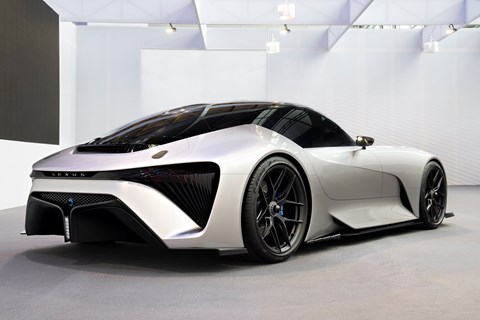► This is Lexus’s next supercar, and it’ll be an EV
► Production model to follow LFA’s footsteps
► This time, it’ll use GT3-spec engineering
You might recognise this car. It’s the Lexus Electrified Sport concept – something that’s been dangled like a carrot on the end of a very long electrification stick-shaped by Toyota and Lexus for the best part of a year.
Details up to now had been scant, as the car sat between endless concept cars from both Japanese brands as its plans to go electric were laid bare by Toyota’s boss, Akio Toyoda. Now, though, Lexus is ready to talk, as this sleek, striking car will make production.
Toyota Europe boss, Matt Harrison, calls the Electrified Sport ‘our vision for a full-electric sports car,’ and Lexus Europe boss Pascal Ruch tells CAR that the production-spec version of this concept will ‘be like a cherry on the cake’ for a next-generation range of cars from Lexus.
Is this the return of the LFA?!
Sort of. The Electrified Sport is battery-electric and, while performance specs aren’t nailed yet (because, frankly, the production car itself isn’t entirely nailed down yet), Lexus claims a two-second 0-62mph sprint time.
And, this time, Lexus is planning on going much more digital than before. The production version of the Electrified Sport will have the brand’s One Motion Grip steer-by-wire system (first seen on the Lexus RZ, and tested here) as well as brake-by-wire technology. We know that the production-spec car will have at least two electric motors, as Lexus’ ‘DIRECT4’ all-wheel drive system will be included, too.

‘We can create any kind of characteristic given it’s done through software, which is a massive benefit,’ chief engineer for Lexus Electrified, Takashi Watanabe, tells CAR. ‘Take steer-by-wire, we can control the amount of tyre movement matched to the preference of each individual person. For a production car, regulations don’t allow us to offer that on the road. But let’s say you go to a racetrack: there, you’ll have the ability to customise the steering angle, even the throttle – and control it how you want to.’
And as for links to that Yamaha-engined masterpiece from more than a decade ago? Watanabe is more than happy to draw those comparisons himself: ‘definitely the packaging and weight distribution and even just the base potential of the vehicles are similar,’ he says, ‘and if you actually take the diagrams of this and the LFA and overlay them, they are very close to each other.’
You mentioned GT3-spec engineering?
That’s what chief engineer Watanabe wants to bring to the road: ‘BEVs are heavy,’ he says, ‘so the lighter the car the better. Taking that experience from GT3 racing is what we’re going to apply to solve that.

‘As for the powertrain, we’re talking about something with very high power loads, motor control, efficiency so we have to develop a system that can handle all of that. That’s why motorsport will really play a big role with this car’s development.’
When can I have one?!
That bit we’re not sure about. Clues Lexus has left (including new-generation battery technology incoming in the next couple of years) implies that we won’t see a production model until around 2025, if not beyond.

What we do know is that Watanabe and his time are fighting tooth and nail to make sure as much of the concept’s design elements, as well as that big shopping list of engineering innovations, makes it in one piece to the final production car.
And as for a price tag, expect something like the LFA’s entry fee. As in, it’ll be high.